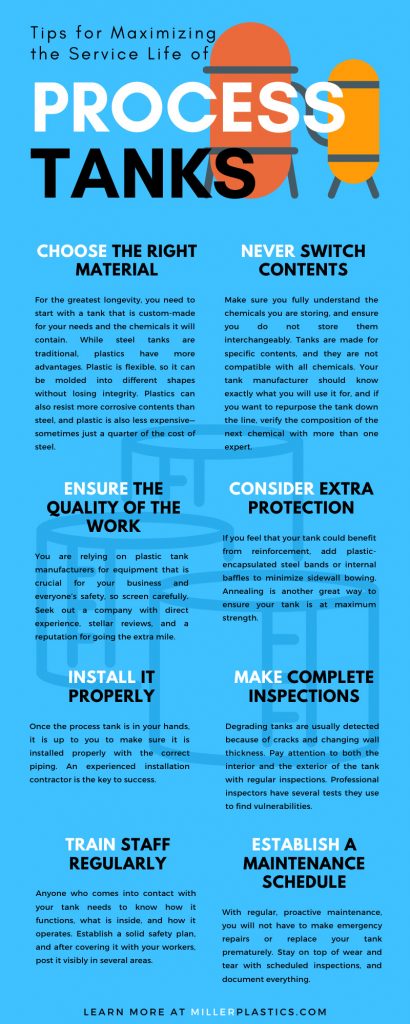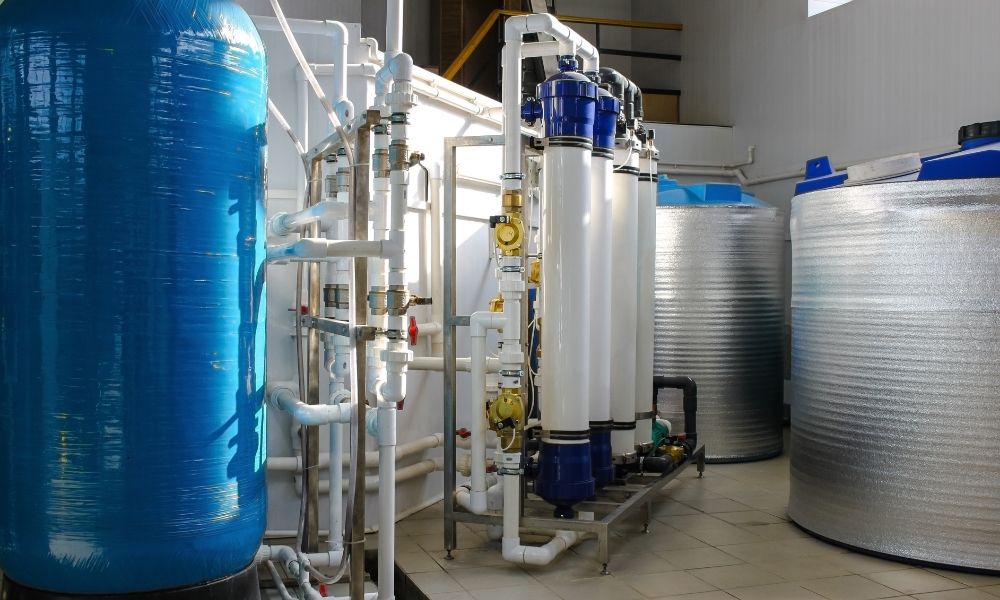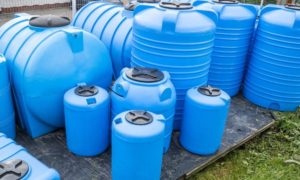When you are investing in a process tank, you must keep a lot of significant considerations in mind. There is the size of the tank, for starters—it might be 50 feet long—but your main concern is safety. You need equipment that will protect your workers, your facilities, and the environment. Another priority is durability; a tank can last up to 20 years, but only in the right conditions. These tips for maximizing the service life of process tanks will keep them functioning at their best for as long as possible.
Choose the Right Material
For the greatest longevity, you need to start with a tank that is custom-made for your needs and the chemicals it will contain. While steel tanks are traditional, plastics have more advantages. Plastic is flexible, so it can be molded into different shapes without losing integrity. Plastics can also resist more corrosive contents than steel, and plastic is also less expensive—sometimes just a quarter of the cost of steel.
Plastics are strong and durable, but each kind has different properties you should match to your application. With more complex chemistries and higher temperatures, it is even more important to get it right. At Miller Plastics, we make tanks with all kinds of materials. For whatever materials we use, they all have one thing in common: our custom plastic water tanks use 100 percent virgin American-made materials. Here are a few plastics we trust:
Polypropylene
With its superior resistance to chemicals and corrosion, Polypropylene is strong and stable. It is easy to produce and has a 200°F working temperature.
Lexan
Lexan has outstanding properties—mechanical, optical, electrical, thermal—across the board. It is particularly well-suited for welding.
PVC
Polyvinyl chloride is rigid yet flexible, at a surprisingly low cost. Its continuous working temperature is 200°F.
Polyethylene
Low-density polyethylene (LDPE), high-density polyethylene (HDPE), and ultra-high-molecular-weight polyethylene (UHMWPE) all have a continuous working temperature of 180°F.
CPVC
This is a great low-cost option for high heat distortion temperature, chemical inertness, and flame and smoke properties. The continuous working temperature of CPVC is 200°F.
Kynar®
For plastic tank manufacturing applications, this has the highest purity, strength, and resistance to harsh acids, solvents, bases, and heat. Its continuous working temperature is 235°F.
Consider Extra Protection
If you feel that your tank could benefit from reinforcement, add plastic-encapsulated steel bands or internal baffles to minimize sidewall bowing. Annealing is another great way to ensure your tank is at maximum strength. Hard, brittle materials can be difficult to bend without creating a material fracture. Annealing helps eliminate this risk. It is a heat treatment process that reduces the hardness of materials, while increasing ductility. This makes the material easier to handle, and removes residual stresses that can lead to cracks and other complications.
Ensure the Quality of the Work
You are relying on plastic tank manufacturers for equipment that is crucial for your business and everyone’s safety, so screen carefully. Seek out a company with direct experience, stellar reviews, and a reputation for going the extra mile. Check for manufacturing equipment featuring the latest technology, or at least up-to-date capabilities.
At Miller Plastics, we hold ourselves to a higher standard. Our plastic tanks are produced with Finite Element Analysis for greater performance and minimal bowing. We anneal many of our projects and adhere to formal procedures. Our technicians are AWS-certified for welding, which is essential for tanks that will contain harsh chemicals and acids. Patented welding advancements guarantee smooth, burr-free finishes to prevent sediment buildup and allow for easy cleaning. All edges and components are CNC cut; nothing leaves our shop with sharp edges.
Install It Properly
Once the process tank is in your hands, it is up to you to make sure it is installed properly with the correct piping. An experienced installation contractor is the key to success. You will need offloading equipment big enough to handle your tank and set it in place without causing damage. You can protect the integrity of your new tank with a concrete pad or crushed gravel. Incorrectly installed tank anchors can cause tanks to deteriorate more quickly, as can an uneven foundation.
Train Staff Regularly
Anyone who comes into contact with your tank needs to know how it functions, what is inside, and how it operates. Establish a solid safety plan, and after covering it with your workers, post it visibly in several areas. Make sure that each new employee has thorough training and that your staff reviews operating procedures on a regular basis. Keep up on updated safety standards, and pass on this continuing education.
Never Switch Contents
Make sure you fully understand the chemicals you are storing, and ensure you do not store them interchangeably. Tanks are made for specific contents, and they are not compatible with all chemicals. Your tank manufacturer should know exactly what you will use it for, and if you want to repurpose the tank down the line, verify the composition of the next chemical with more than one expert. If you are not conscientious, you can contribute to the degradation of your tank, or even cause a dangerous chemical reaction.
Establish a Maintenance Schedule
With regular, proactive maintenance, you will not have to make emergency repairs or replace your tank prematurely. Stay on top of wear and tear with scheduled inspections, and document everything. You cannot afford any breakdown in operations, and if you keep an eye on damage, it will not grow beyond repair. Operator safety depends on fresh eyes to assess their equipment.
Make Complete Inspections
Degrading tanks are usually detected because of cracks and changing wall thickness. Pay attention to both the interior and the exterior of the tank with regular inspections. Professional inspectors have several tests they use to find vulnerabilities. Candling shines a bright light through the tank shell to illuminate weaknesses. Another method is to apply water-soluble dye to the tank, which will seep into cracked areas and show up under ultraviolet light. But piping systems can also fail due to excessive vibration, or at joint connections and fittings. Make sure you are assessing your tank as a whole.
You need to start with high-quality equipment to take advantage of these tips for maximizing the service life of process tanks. Get it right from the beginning with Miller Plastics, which has been manufacturing tanks for 50 years. We value our loyal customer base, so we always use highly skilled workers and the best technology. Contact us for plastic tanks that stand the test of time.





